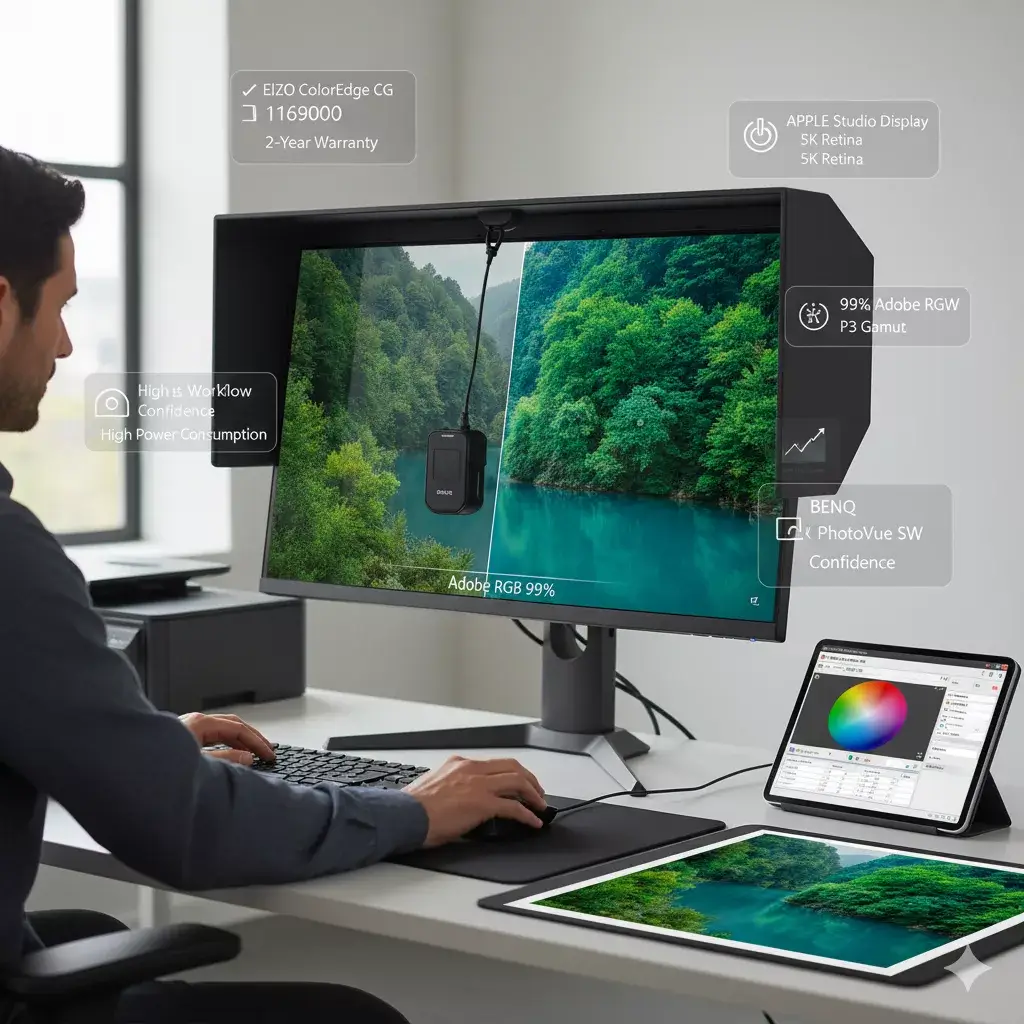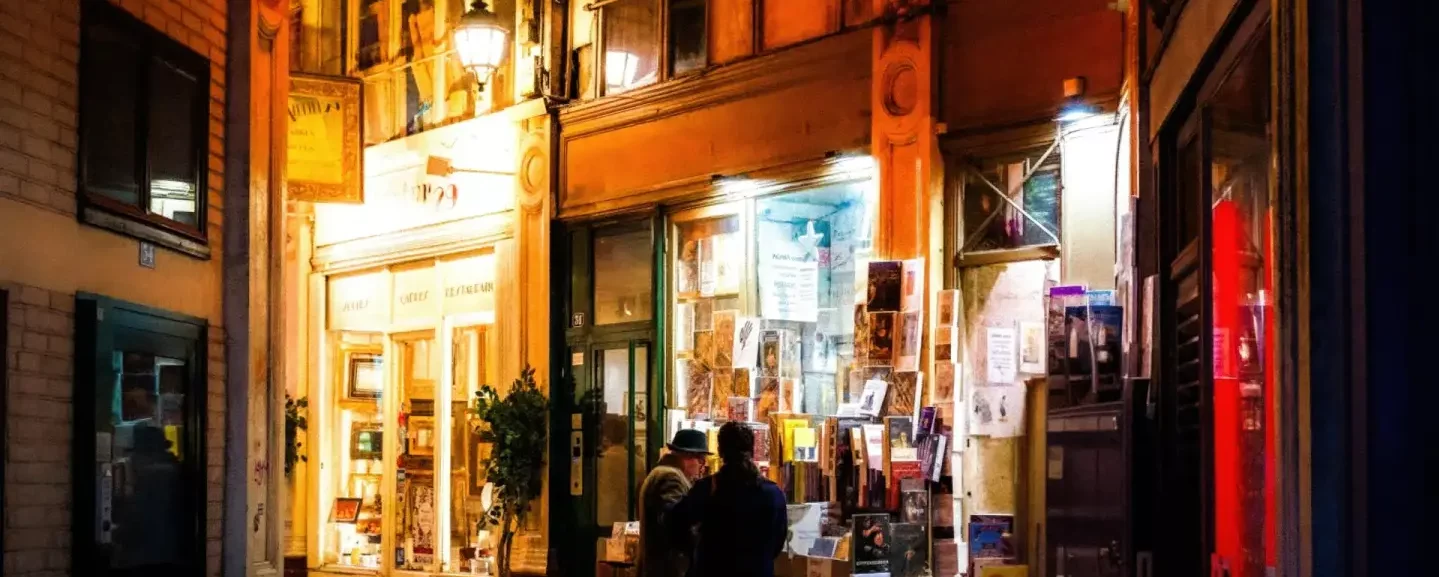
Introduction: In the digital workflow, the monitor is not merely an output device. It is the nerve center, the benchmark, the ‘darkroom’ where all critical decisions are made. After camera optics, it is the most crucial investment for a photographer. A poor quality or improperly calibrated monitor nullifies the potential of a €5000 sensor. It forces you to work ‘blindly’. Choosing your monitor is not about comfort; it is about confidence. Here, we analyze the market’s benchmark options, their technologies, costs, and their true contribution to your art.
I. The Pillars of a ‘Photographic’ Monitor
Before comparing models, it is essential to understand what distinguishes a ‘pro’ monitor (€400 – €5000) from a consumer monitor (€200).
- Gamut (Color Space): This refers to the range of colors the monitor can display.
- sRGB: The standard web color space. Insufficient for photography.
- Adobe RGB (1998): The reference color space for printing. It contains richer greens and cyans, which are crucial for fine art prints. A professional monitor must cover at least 99% of Adobe RGB.
- DCI-P3: The digital cinema color space, widely adopted by Apple. Excellent for video and web browsing, but less broad than Adobe RGB in certain key areas for printing.
- Panel and Uniformity: A ‘pro’ monitor uses a panel (generally IPS) with uniformity compensation circuits. This ensures that white appears consistently from the center to the corners. A consumer monitor is often brighter in the center.
- Delta E (ΔE): This is the measure of color accuracy. Below ΔE
2, the human eye can no longer perceive the difference between the requested color and the displayed color. Professional monitors are factory-calibrated with a ΔE<2. - Hardware Look-Up Table (LUT): This is the ‘brain’ of the monitor. A standard monitor is ‘software’ calibrated (the graphics card is altered). A professional monitor is ‘hardware’ calibrated (the profile is stored within the monitor itself), which is non-destructive and infinitely more precise (often 14 or 16-bit).
II. The Contenders: Three Market Philosophies
We will compare three archetypes that dominate the professional and ‘prosumer’ market:
- The Absolute Reference: Eizo (ColorEdge CG Series)
- The Professional Standard (Price/Performance Ratio): BenQ (PhotoVue SW Series)
- The ‘Creative’ Ecosystem: Apple (Studio Display / Pro Display XDR)
III. Detailed Comparative Analysis
| Criterion | Eizo ColorEdge CG (e.g., CG2700S) | BenQ PhotoVue SW (e.g., SW272U) | Apple Studio Display |
| Advantages | Absolute precision, perfect uniformity, integrated calibration sensor, legendary reliability (5-year warranty). | 99% Adobe RGB, hardware calibration, excellent price/performance ratio, included shading hood. | 5K resolution (incredible text clarity), brightness (600 nits), macOS integration, audio quality. |
| Disadvantages | The PRICE. Power consumption. Less versatile for ‘everyday’ use (e.g., gaming). | Very good uniformity, but a step below Eizo. The sensor is not integrated. | Glossy panel (reflections), P3 gamut (not Adobe RGB), locked hardware calibration. |
| Cost | Very High (€2200 – €5500) | High (€1000 – €2500) | High (€1750 – €2500) |
| Build Quality | Exceptional (Industrial grade). Made in Japan. Designed to last 10 years. | Very good. Dense plastics, robust assembly. | Exceptional. Single block of aluminum and glass. |
| Manufacturing Defects | Virtually non-existent. Medical-grade quality control. | Rare. A few cases of ‘backlight bleed’ or dead pixels, but well below average. | Glossy panel very sensitive to dust under the glass (rare). Reflection management criticized. |
| Estimated Lifespan | Extreme (30,000+ guaranteed hours of use). 5-year manufacturer’s warranty. | Very long (estimated 5-8 years). 3-year warranty. | Long, but often tied to the Apple product lifecycle. Non-repairable. |
| Configuration Difficulty | Very Low. The software (ColorNavigator) is the best on the market. Auto-calibration makes the process seamless. | Low. The software (Palette Master Element) is effective for hardware calibration but less ‘automatic’ than Eizo. | None (if remaining within the ecosystem). Complex (if precise calibration is desired outside of Apple). |
| Versatility | Low. It is a specialist’s tool. Low refresh rate (60Hz). | Medium. Good for video (certain models), but remains a photographer’s tool. | Very High. Excellent for everything: office work, UI/UX design, video, audio. Less suitable for print photography. |
| Power Consumption | High (but managed by presence sensors). | Medium to High. | High (due to 5K resolution and 600 nits). |
| Necessity | Essential for high-end fine art printing and commercial prepress. | Essential for any professional photographer (wedding, studio, landscape) who prints. | A ‘luxury’ for photographers, a ‘standard’ for videographers or UI designers. |
Export to Sheets
IV. The Critical Point: Calibration and Maintenance
Purchasing a monitor is only the first step. Maintaining its accuracy is the second.
Calibration Probes (The Hardware) A monitor ‘lives’. Its colors drift over time. Calibration is necessary every 1 to 3 months. For this, a probe (a colorimeter or spectrophotometer) is essential.
- Key Players: The market is dominated by two brands:
- Calibrite (formerly X-Rite): Their series (ColorChecker Display) are the industry standard. The ‘i1Display Pro’ (or its successor) is the benchmark.
- Datacolor: Their ‘SpyderX’ series is very popular, known for being faster, although some purists prefer Calibrite’s accuracy in low light.
- Cost: A reliable probe costs between €150 and €350. This is a mandatory maintenance cost for a BenQ or Dell, but included with an Eizo CG.
Calibration Software (The Brain) This is where the difference between ‘hardware’ and ‘software’ calibration lies.
- Manufacturer Software (The Best):
- Eizo ColorNavigator: The king. It communicates with the integrated (or external) sensor and the monitor’s hardware LUT. It is fully automated.
- BenQ Palette Master Element: Very effective. It uses your external sensor (Calibrite, Datacolor) to write directly to the monitor’s 16-bit LUT. This is true hardware calibration.
- Probe Software (The Standard):
- The software provided by Calibrite or Datacolor. They are good, but on a non-professional monitor, they create an ICC profile that corrects the graphics card output. This is a ‘software’ correction, less precise and potentially causing banding (breaks in gradients).
Apple’s Case: The Studio Display is a closed system. It is designed to be ‘accurate’ out of the box… for P3. Calibrating it for Adobe RGB is complex, if not physically impossible. One trusts Apple, which is the antithesis of a professional photographer’s approach.
V. Contribution to Workflow and Necessity
What does a professional monitor offer? CONFIDENCE.
The benefit is simple: what you see is accurate.
- You no longer have to guess if your photo is too dark or if it is your monitor.
- You will no longer be surprised by a dull print when the image appeared ‘vibrant’ on screen (a sign of an overly saturated or bright consumer monitor).
- You work faster. Your skin tone adjustments are accurate on the first attempt.
- Your black and white images retain shadow detail, as the monitor is capable of displaying them (good gamma point).
Is it a necessity?
- For the Web (Instagram, portfolio): A P3 monitor (like Apple’s) or a well-calibrated sRGB monitor is often sufficient, as your audience will view content on phones (P3).
- For Printing (Fine Art Prints, Books): A 99% Adobe RGB monitor (BenQ or Eizo) is non-negotiable. It is an absolute necessity.
VI. Conclusion and ‘The Icing on the Cake’: My Choice
Purchasing a monitor is a long-term investment, longer than that of your camera body.
- The ‘Ultimate’ Option (Unlimited Budget): Eizo ColorEdge CG. It is the ‘once and for all’ purchase. The integrated sensor and 5-year warranty justify the price for those whose income depends on absolute color accuracy. It is an industrial tool that provides complete peace of mind.
- The ‘Pro’ Option (The Smart Choice): BenQ PhotoVue SW. This is the easiest recommendation to make. It offers 95% of an Eizo’s performance for 40% of its price. The requirement to purchase a separate sensor (approx. €250) is a small cost to access hardware calibration and the Adobe RGB color space.
- The ‘Designer’ Option (The Ecosystem): Apple Studio Display. If you never print and primarily work for the web, video, and appreciate 5K resolution for text, this is a magnificent monitor. However, for a ‘purist’ photographer, paying this price for a glossy panel locked to P3 is nonsensical.
🍒 the Maestro’s Favorite Pick
My favorite choice, the one I recommend to 9 out of 10 professionals, is the BenQ PhotoVue (SW range, for example the SW272U – 27″ 4K or the SW321C – 32″ 4K).
Why?
Because it is the triumph of rationality. Eizo is a dream, but its price is exponential; one pays dearly for the last 5% of perfection (perfect uniformity and integrated sensor). Apple is a superb piece of design, but its technical choices (glossy, P3) are a dead end for printing.
BenQ has made the photographer’s choice:
- Priority to Adobe RGB (99%): They target printers.
- Hardware Calibration: They respect the professional workflow.
- Included Accessories: The shading hood (often a €200 option elsewhere) is included.
- Price: It is fair. It is an accurate reflection of the embedded technology, without the ‘luxury’ of Eizo or the ‘brand’ of Apple.
The BenQ SW is the tool for the pragmatic professional. It makes no compromises on what matters (color) and eliminates the superfluous, offering the best performance-to-price ratio on the market for those who take color seriously.
This post is also available in:
French
